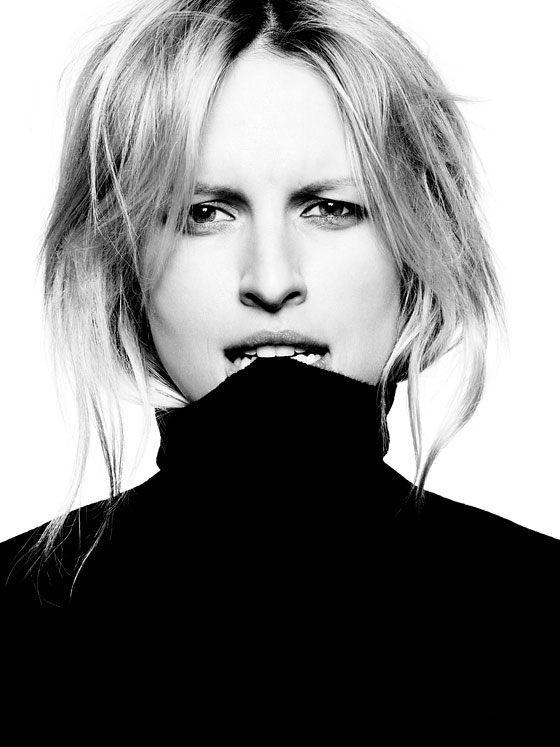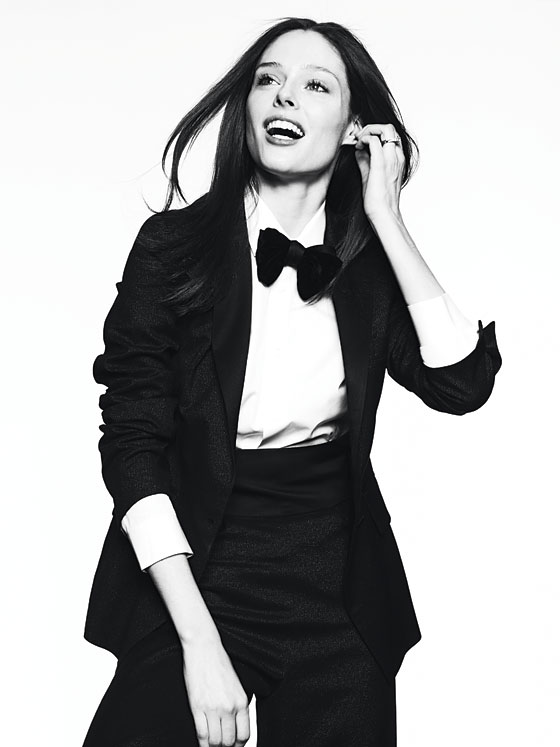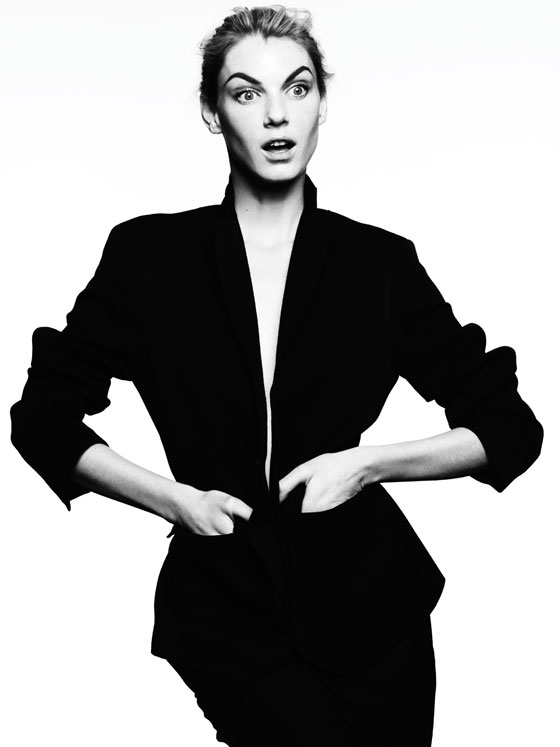
High above New York on the 21st-floor balcony of the Cooper Square Hotel, German television is filming Karolina Kurkova teaching ten aspiring models how to walk a runway. “It literally looks like we’re walking on skyscrapers!” the Czech native, 27, says in enthusiastic English that later will be partially dubbed over in German. The girls, plucked from a Deutschland-wide search, at least pretend to understand.
Battling stiff winds and language barriers, Kurkova demonstrates three runway walks: high fashion, couture, and “show,” which basically means pretending to wear giant Victoria’s Secret wings—a technique in which Kurkova is quite expert. Then, to the delight of the Teutonic producers, she gets her heel stuck between floor slats. Her fumbling to free herself is a moment that, along with the many times she bursts into tears eliminating girls, will be played on repeat in stridently dramatic European promos.
The show, called Das Perfekte Model (The Perfect Model), is Kurkova’s first step toward building the kind of career that keeps a model in the spotlight after shoots have dried up. The greatest post-modeling successes in the past decade have been Heidi Klum and Tyra Banks. And not surprisingly, Kurkova and her producers are billing Das Perfekte Model as a toned-down, “documentary-style” counterpart to Klum’s second-best-known TV-hosting gig: the megahit Germany’s Next Topmodel (itself derived from Banks’s Top Model juggernaut).
Looming in the background of every model’s career, even one as thriving as Kurkova’s, is the inevitable fear: aging out. The thirst for fresh faces in modeling is so intense that the Council of Fashion Designers of America has issued a plea for designers and modeling agencies not to let girls under 16 walk at New York Fashion Week. Not everybody complies.
So what’s a woman shunned from a girl’s world to do? Try acting (Milla Jovovich, Amber Valetta, Charlize Theron, Cameron Diaz, Tyra Banks), play music (Karen Elson, Irina Lazareanu, Banks again), become a photographer (Helena Christensen, Banks again), start a beauty line (Miranda Kerr), start a yoga line (Christy Turlington), start a clothing line (Kate Moss, Erin Wasson), start a jewelry line (too many to count), start a furniture line (Cindy Crawford), get a bachelor’s in comparative religion and Eastern philosophies (Turlington again), run a charity (where to begin), run for Estonian Parliament (Carmen Kass), marry rich (Stephanie Seymour, Christie Brinkley), or become the First Lady of France (Carla Bruni).
In dance, another industry ruthless in spitting out its genetically gifted workers, there’s actually a foundation for “career transition” funded by the Newhouse family. Modeling has no such safety net. “You’d be stupid not to think you have a shelf life,” says Iman, 56, who now runs a $25 million cosmetics company. “I knew I had to become a brand. And that brand was me.”
But the trick for Kurkova and two other models who are thinking hard about their futures—Coco Rocha and Angela Lindvall—is how to build a populist brand without screwing up their still-active careers as high-fashion models.
Put another way: Can a QVC line ever coexist with the cover of Vogue?
The youngest of the three is Rocha, age 23, who’s big enough she got a shout-out in a Kanye West song; Tyra Banks has called her “the queen of posing.” Rocha thought “modeling was just going to be a summer thing and then I’d go home,” she says. “Then I went to Asia. Then I worked with Steven [Meisel].” Now she even has friends like Karlie Kloss, 19, arguably the most famous face of her generation, joking that girls in Rocha’s class (“the old-lady crew,” as Rocha calls them) have stuck around too long. Yet Rocha is convinced she’s found modeling’s holy grail for longevity: social media. “Once I started making noise, I thought, I’m not going anywhere.”
Making noise certainly worked for Heidi Klum, 38, who started her career in 1992—too late to be a supermodel and too curvy to be a waif. Clothes “would get stuck on my boobs,” Klum says. She wound up doing catalogues until she “nagged and nagged and nagged” Victoria’s Secret. She got a publicist, who helped her get Sports Illustrated, which led to Leno, which proved she could do TV, which led to Project Runway and her becoming far more influential in fashion than she ever was as a model.
It also worked for Cindy Crawford, 46. Against her agents’ advice, she took an unpaid job as the first host of MTV’s House of Style, which gave her a new, large, male fan base that led to a huge campaign with Pepsi. “I definitely made a choice to go more all-America,” she says. “I felt that was my brand.”

Rocha started thinking about her brand in 2007 with a Tumblr blog called Oh-So-Coco. “I was ready to do more than take pictures,” she says. “I was ready to talk.” The web was where she could deny she had cancer (she’d dyed her hair red for Vogue and had to keep it under wraps with a wig); take on haters who criticized her perceived weight gain; and write things like “Just kicked @KarlieKloss out of the house after she ate my last 2 boxes of cereal. You know I love my cereal!!”
Rocha calls herself a nerd, which might be a tough brand to push as a model. She prefers gadgets to clothes. She is heavily involved in charity, and made a documentary in Haiti. She was discovered at an Irish-dance competition in Canada, and the fashion moment everyone remembers her for was the February 2007 Gaultier show in Paris when she did a jig down the runway.
Also hard to sell: She’s kind of a prude. Or, depending on how you look at it, a staunch advocate for models’ rights. At 16, she got pressured into doing a semi-nude shoot. And from then on she laid down parameters: no cigarettes, no nudity, no lingerie, which means no swimwear because that could make people think she’s willing to do lingerie. This also effectively means no Victoria’s Secret, often a launchpad into TV. And no acting. She’d like to try it, but she won’t curse. “Unless it was like the next Jane Eyre, there really isn’t a lot I could do,” she says.
She’s not kidding around. The other day, Rocha found herself on a shoot with three male models who were unexpectedly “inappropriately clothed,” she says. “I mean, I don’t have a problem with male models, but if I have told you that this is not what I do, either they have to go or I have to go. So, in the end, they had to leave. How terrible does that make me look? But it’s too bad people don’t stick to their guns. And read the contract and realize this is not what Coco’s going to do. We can’t trick her into it.” (Rocha is mentoring Kloss on tweeting more, but otherwise, Kloss is growing up all on her own. She just did a controversial nude shoot, her first, for Meisel in Italian Vogue. The truth is that not all girls want to take over the world,” Kloss told me. “I want to take over the world.”)
Rocha believes that if her online following is too big to be ignored, she can get ad campaigns no matter what her contract says. We’re talking over espresso with Rocha’s British husband, James Conran, who helps manage her mini empire. With her Twitter, Facebook, Tumblr, Google+, and other platforms—including Tencent Weibo, a.k.a. “Chinese Twitter”—combined, Rocha is up to 1.65 million followers. Google+ is her House of Style: Her 588,000 followers there are mostly guys from India and Asia.
Could that translate to profit? As Conran puts it, “If she’s speaking to 580,000 people on Google+, that’s worth something. I don’t know what, but something.” Should brands pay her extra to tweet a photo of, say, a Rodarte campaign she’s in?
When she started doing social media, Rocha was worried the oversharing might cause the industry to un-follow her. “You’re supposed to be high fashion, exclusive, untouchable,” she says. Now she’s not as concerned. “High fashion may decide that she’s old news,” says Conran. “But a girl like Coco who has a million followers is not going to disappear overnight. Clients will still want her. Even if the few people who kind of control fashion decide they don’t like Coco, it’s not that easy for Coco to disappear.”
Anyway, she’ll always have Canada. She’s covered the red carpet for Entertainment Tonight Canada and done backstage interviews at the very shows she’s walked in. Doing Canadian TV was her agent’s plan. “He was like, ‘We need you to get famous in Canada.’ Say America is done with you, Canada will be like, ‘We’ll take anything!’ ”
When Jay-Z was seeking a big name to co-host an after-party for his Carnegie Hall benefit concerts last week, he called Karolina Kurkova. Her brand equity is model as entertainer, the person to turn to when you want to spike enthusiasm at some fancy event. It comes from growing up as a five-eleven teenager, she says. “I was never the girl the boys wanted to date. Being funny was my shtick.” The morning of Jay-Z’s party, Kurkova, mother to Tobin, 2, excitedly (and graphically) showed me the breast-feeding techniques she planned to teach the rapper that night for Blue Ivy.

Kurkova became one of the youngest Vogue cover girls ever at age 16, two years after a friend had sent her photo to a modeling agency in Prague. She later beat out Angelina Jolie as E!’s Sexiest Woman in the World. If anyone can improve upon the example of Heidi Klum, it’s probably her. And she’s been trying very hard to reignite her international presence. In the past year, she’s been on the cover of five Vogue magazines around the world. Her Vogue Brazil was the highest-selling cover in the magazine’s history, better even than the one with Gisele.
But she’s had some ground to make up. A rough patch in 2008 may have left her less financially solvent than she’d like to be now. Stressed from work and a “not great relationship”—with a booker twelve years her senior who was “very controlling”—she developed hypothyroidism. “I was getting migraines. I was having panic attacks. I thought I was going crazy.” She also gained 30 pounds.
She took care of it, thanks to rest, homeopathic remedies, and Archie Drury, 39, a former Marine who became her husband. They first saw each other in a restaurant when she was at her heaviest. She reached out to him on Facebook, but he didn’t recognize her glossy profile pic, and having had a bad experience on a dating website, he worried he might be corresponding with a man. They cleared up the gender confusion; now Drury helps her strategize career moves.
Except that beyond TV, Kurkova can’t articulate what’s next. Maybe a baby line, maybe a beauty line, maybe singing. “You have to live in the moment,” she says. “Not everything you can plan.” This is not flakiness, says Ivan Bart, who runs Kurkova’s agency, IMG Models: “A lot of models like to talk about what they’re going to do, but then they expect someone else to do it. They’re like, ‘I want to write a book!’ And then three days later they’re like, ‘Where’s my book?’ Karolina knows that if she wants to write a book, she has to write the damn book.”
She was offered two other high-profile American fashion TV-hosting gigs. But “[Das Perfekte Model] was the show she thought she was ready for,” says Bart. That it would air out of the country was appealing—like previewing a play in New Haven. Also the Germans gave her a large degree of creative control. “I don’t want to be mean” to the contestants, says Kurkova, who shares mentoring duties on the show with locally famous German model Eva Padberg.
“It is a fight every day,” says one of the show’s producers, rather exasperatedly. “How do we structure a program where I need drama and she wants to care for the girls?” The team came up with a brilliant solution: provide Kurkova with a midget translator sidekick. “Then everybody would see Karolina and Eva and the midget and say, ‘Two models and a half!’ People would talk about that.”
Kurkova put her foot down, the producer says with a sigh. “It’s still a good idea.”
Angela Lindvall’s 9-year-old son, Dakota, pulls out a massive hand-drawn map of his home and surroundings in Topanga Canyon, California. It stretches to the farthest reaches of his temporal understanding, which is as far as he and his 6-year-old brother, Sebastian, have wandered, which was far enough to get very, very lost with a friend and never get invited to have play time with him again. Dakota’s rendering of the seven-acre refuge his mother has carved out for them in this insular community near Los Angeles has a similar feel to the maps of Middle-Earth, albeit with more misspelled words. This is fitting, given just how removed their utopian existence is from the fashion world in which his mother makes her living—and because he and Sebastian are currently building Gondor out of Legos in the back room.
On the night I visit their large ranch house, Lindvall, 33, has invited over some neighbors for Persian meatballs (prepared by her nanny) and kale salad (prepared by Lindvall) to discuss last night’s community meeting about trying to get Topanga off the grid and into self-sustaining farming. At the start of each year, she makes a “pie-graph calendar” with goals for each month, and one of 2012’s is to get her own land off the grid while Topanga catches up. After that, she says, “I’m going to get chickens.”
She still has her pie-graph calendar from 2011, and “believe it or not, last year I put on there ‘branding initiative,’ and I wasn’t really sure what it was going to be, and I put in ‘TV,’ and I wasn’t sure what it was going to be.” The branding initiatives were starting her website, angelalindvall.com, and a QVC partnership with John Hardy to design a collection of ecofriendly recycled-silver jewelry. TV was an unexpected opportunity. She’s now host of Project Runway All Stars, a good move for Lindvall, though it has infuriated certain fans of the franchise. (One rumor is that the Weinstein Company scrapped the original panelists—Heidi Klum, Michael Kors, and Nina Garcia—when they demanded a raise.)

“I’m not going to read my press or anything,” she says. “I started reading some stuff yesterday, and I got in a dark mood. There’s this guy who, I’m sure, lives in a dark apartment and eats chips all day and had only nasty things to say.” Among his criticisms: She’s “edgeless” and “not Heidi.”
Part of the edgeless critique may be owed to Lindvall’s paralyzing fear of public speaking. She says she overcame it in time for the live finale. Also, if she comes off particularly stiff in the first few episodes, which she does, it’s because “a guy with a really thick British accent” was feeding her one line at a time via a bug in her ear. “I think because Heidi’s German, it’s better for her” that way, says Lindvall. “Finally, by the third episode, I was like, ‘You guys, I can memorize lines.’ ”
Lindvall also had to deal with producers insisting she wear sexy dresses and really big hair. “They actually wouldn’t let me wear my hair up because they said I looked too much like Heidi,” she says.
Lindvall’s No. 1 fear upon being discovered at 14 at a Kansas City fashion show, not far from where she grew up in rural Lee’s Summit, Missouri, was that she might become famous. “I told my managers, ‘I don’t want to be on the cover of any magazines.’ ” She wound up on the cover of every major magazine. Yet she couldn’t shake the thought that it might all be over soon. “Other girls would be like, ‘I made twenty grand on that show,’ and then go spend ten. And it’s like, ‘Well, how long do you think you’re going to be making that money?’ ”
What she hadn’t anticipated was getting pregnant quite so young, or going to the British Virgin Islands and meeting her future husband, a South African diver named William Edwards. They’re divorced, but he lives nearby and is still in the family’s life. Lindvall’s becoming an organic-food nut came from her great anxiety that if she didn’t work off the 75 pounds she’d gained while pregnant with Dakota she’d never work again. “I was always just one of those skinny rats that never really exercised,” she says. “That all changed. So I was running up these hills in the British Virgin Islands imagining Gisele’s ass.”
She wasn’t able to bounce back as quickly after Sebastian’s birth. “I went through the hardest time of my life, unfortunately for him,” she says. Her marriage with Edwards was ending, she’d moved to L.A., and in 2006 her younger sister, Audrey, also a model, was crushed by a truck while riding her bike back in Missouri. “I kind of fell off the face of the Earth for a little while,” she says.
The disappearing had certainly hurt her career, but she’d gotten enough clarity from Audrey’s death to just be happy with what she had. “I was like, ‘If all I do is catalogue, then all I do is catalogue.’ And then it didn’t happen that way—and I was like, ‘God, the universe is blessing me, thank you.’ I feel very, very, very lucky. You know, I’m not doing every Italian Vogue cover now. But I’m working with a lot of great advertisers.”
She’s also tried acting—but so far has landed only small parts. “I got close to getting some things, but you’re not getting any perks because you’re a model. And so for me to do this little part that takes two weeks to film—and they don’t give a shit about your time—it doesn’t really make sense.”
Lindvall recently read for the part of Glinda the Good Witch in Sam Raimi’s Oz: The Great and Powerful. When Robert Downey Jr. was set to play the Wizard—“he would have been the best Wizard ever”—the idea had been to cast “iconic women but not famous actresses” as the witches. After he dropped out, replaced by James Franco, “it’s disappointing, but they needed star actresses to carry off the witches. So I lost the Glinda role.” It went to Michelle Williams.
She still needs to work. She’s not like Natalia Vodianova or Stephanie Seymour, she points out. “They married rich husbands. They don’t have to worry about anything.” And the day when she’ll have to stop modeling, she knows, is ever closer. “We’re all going to get older, we’re all going to get wrinkles, we’re all going to lose our body,” she says. “It’s a part of life, and it could be a hard thing to embrace in this industry. You could get pretty sad. Especially if you’re living completely engaged in that whole world of fashion and then nobody wants you anymore and none of them were your real friends anyway. And then you go and, like, slit your wrists.”
She checks herself. “Just kidding … I’m not going to name names, but there are definitely some people that kind of lose their marbles.” She goes on: “Imagine a girl who loves opening all the shows, and suddenly she doesn’t get all those free clothes. She doesn’t get the money. She doesn’t even get invited to the parties anymore. And then what? Is she going to go work an office job? I would have a hard time working an office job.”
Even Dakota seems aware of a model’s shelf life, which is why he told her to do Project Runway. “My son’s so funny. He’s like, ‘Mom, you better do this job because your career is not gonna last forever.’ ”
But when the John Hardy QVC opportunity came up, Lindvall hesitated, even though its ecofriendly values were right in her wheelhouse. “I was just thinking, ‘Things are going really great in my career, and QVC is a major different direction,’ ” she explains. “I was thinking about how my brand image was going to be affected.” There’s a fear, she says, that if a model goes too commercial, Anna Wintour won’t want her anymore. But “Anna Wintour hasn’t put me in her magazine for a while now, you know, so …” She laughs. “For me, I mean—my manager is going to get so mad at me—I’ve already stepped into the boat. I’m doing Project Runway All Stars, for God’s sakes! I’ve gone commercial.”
Dakota comes in. He needs Lindvall to check out the progress on Gondor, and he’s confused about something he overheard her say about a “gay husband.” She explains that she was just talking about a friend.
Then it’s time to turn her attention to the dinner party. As people gather, Lindvall assures her guests, “I’ve got three years’ worth of food supply in the garage.”
See Also:
What Becomes of a Legend Most?

By James Lim